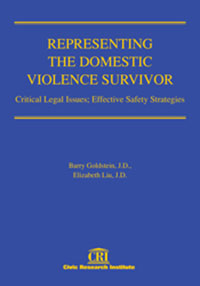The purpose of the book is not to teach lawyers how to practice law. We are assuming they know this. Rather the book is designed to help attorneys understand how to use current scientific research about domestic violence to strengthen their clients’ cases.
We want attorneys to tell judges that there is now a substantial body of scientific research that can be used to better understand domestic violence cases. The research establishes that many of the standard practices used by the courts are working poorly for children. Therefore they are asking the courts to be open to hearing this new information. The information is needed in any case where there are allegations or evidence of abuse. Some court professionals refuse to consider domestic violence expertise because no determination has been made about the validity of the allegations. This is a mistake because the information is needed to inform the decision about the validity of the complaints.
We believe that the three leading sources of good research about domestic violence and custody are the Saunders’ study, The Batterer as Parent and Domestic Violence, Abuse and Child Custody. Significantly, the Saunders’ study which comes from the U. S. Department of Justice cited the other books extensively. We included substantial information from these sources and demonstrated how they can be used to buttress the cases of domestic violence survivors.
We emphasize the research that mothers make deliberately false allegations less than 2% of the time because so many court professionals believe it is more common. We also mentioned that 85% of cases in which mothers raise concerns about child sexual abuse the alleged abuser wins custody. This means a lot of children are being sent to live with their rapists. We have a chapter to help attorneys prepare the pattern of controlling and coercive behavior which should help courts recognize domestic violence. In the chapter about shared parenting we point out that even research most favorable to using shared parenting finds it should only be used under the most favorable circumstances that include both parents genuinely wanting shared parenting, able to cooperate and living nearby. This is obviously not true in cases with abuse allegations and yet many courts still try to promote shared parenting. We have three chapters that respond to the often unqualified mental health professionals relied on by custody courts. The book demonstrates how to cross-examine unqualified evaluators and encourages the use of genuine experts, particularly domestic violence advocates who can present current research to the court.
We are hopeful that as attorneys receive training in best practices and start to present the right information to the court that it will impact all cases. As judges and other court professionals start to hear about valid research and learn the harm the present practices are doing we believe these professionals will start applying this information to other cases just as they now apply the misinformation they are constantly hearing today.
 We will soon be publishing a new book co-edited with Dr. Mo Therese Hannah. The book is called Preventing Domestic Violence and Child Abuse: Medical, Law Enforcement, Judicial and Human Benefits. It is based on our belief that the ACE (adverse childhood experiences) Studies offer a similar opportunity to the 1964 Surgeon General’s Report linking smoking and cancer. ACE tells us that exposure to DV and child abuse causes cancer, heart disease, and many other health and social problems. Many different parts of society helped discourage smoking and in doing so saved millions of lives and trillions of dollars. Preventing DV and child abuse offers the same opportunity. We spoke with the American Cancer Society, American Heart Association, and the CDC about their work to prevent smoking and their work to reduce DV and child abuse. We believe courts and legislators would be more likely to listen to the research that supports protective mothers if the information is coming from these highly respected organizations.
We will soon be publishing a new book co-edited with Dr. Mo Therese Hannah. The book is called Preventing Domestic Violence and Child Abuse: Medical, Law Enforcement, Judicial and Human Benefits. It is based on our belief that the ACE (adverse childhood experiences) Studies offer a similar opportunity to the 1964 Surgeon General’s Report linking smoking and cancer. ACE tells us that exposure to DV and child abuse causes cancer, heart disease, and many other health and social problems. Many different parts of society helped discourage smoking and in doing so saved millions of lives and trillions of dollars. Preventing DV and child abuse offers the same opportunity. We spoke with the American Cancer Society, American Heart Association, and the CDC about their work to prevent smoking and their work to reduce DV and child abuse. We believe courts and legislators would be more likely to listen to the research that supports protective mothers if the information is coming from these highly respected organizations.